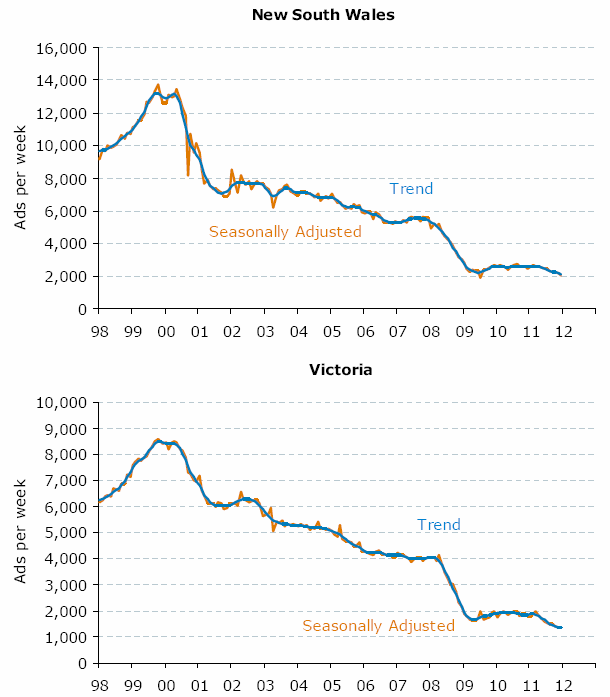The deceleration in job ads continued in December, according ot today’s ANZ Job Ads report:
The number of job advertisements on the internet and in newspapers fell 0.9% in December compared to the previous month. Total job advertisements were 2.6% lower than in December 2010, the first negative annual growth rate since February 2010.
• The fall in total job advertisements was driven by a 1.1% fall in internet job advertising in the month. Internet job advertisements were 2.3% lower than a year ago. In contrast, newspaper job ads were 3.5% higher in December, the second consecutive monthly rise, but remained 9.3% lower than a year ago.
• The notable rise in newspaper job advertisements in December was driven largely by an exceptionally strong rise in job advertising in the Northern Territory. Excluding the Northern Territory, newspaper job advertisements rose 0.8% in December, to be 12.3% lower than a year ago.
• In trend terms, total job ads fell by 0.8% m/m in December and are now 3.4% lower than a year-earlier. Trend growth in job advertising has now been negative since April 2011. However, December does show some divergence in trend growth between internet and newspaper job advertising. While internet job advertising fell by 0.8% in trend terms in December, newspaper job advertising rose 0.1% in the month, the first monthly rise inthis series since February 2010.
Here’s a chart of the growth trend:

Note the weakness is not dramatic but it is likely to be chronic and much sharper in the non-mining states. ANZ agrees:
The total number of job advertisements fell in December in seasonally adjusted terms. This however, reflected quite divergent patterns between internet and newspaper job advertising, with internet job advertising falling while newspaper job advertising rosesharply. This, the second consecutive monthly rise in newspaper job advertising, needs to be watched closely, as newspaper job advertising often leads developments in overall job advertising (and therefore employment growth).
• However, as the Christmas period shows the highest level of seasonal volatility in job advertising, we, as usual, do treat these seasonally adjusted December results with some caution. We will need to await the January and possibly February data before we can confirm these emerging developments. As usual, we therefore focus on the trend data in today’s release for implications for the labour market.
• The modest fall of 0.8% in the trend measure of total job advertisements in December points to at best modest employment gains for the Australian economy over coming months. Indeed, the current trend rate of employment growth is unlikely to be fast enough to absorb the forecast growth in the labour force in the short term. As a result, ANZ forecasts the unemployment rate to rise to 5½% by mid-2012. The unemployment rate is then expected to stay at this elevated level for most of 2012, before falling modestly in 2013 as broader economic activity continues to pick up in response to strong mining and infrastructure investment and a likely extended period of relatively low domestic interest rates.
I broadly agree with the ANZ analysis though expect an unemployment rate closer to 6% by year end. The comparisons between states are nicely illustrated in the newspaper ads charts (making allowances for the structural shift away from newspaper ads). First, the non-mining states:

Versus the boom states:

Full report below.

